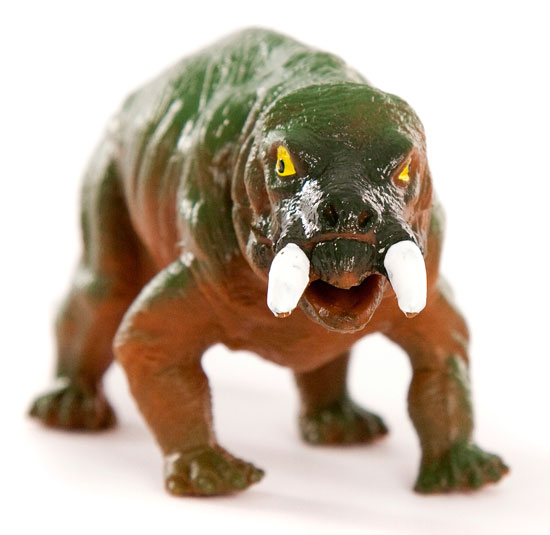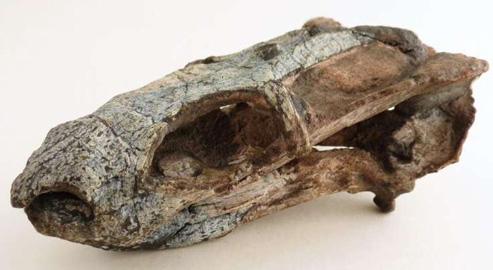Rastodon procurvidens – A Permian “Tusker” from Brazil
Palaeontologists wanting to learn more about a bizarre group of Permian/Triassic therapsids known as dicynodonts usually head to the Karoo Basin of South Africa, a part of the world famous for its reptile fossils. So abundant are the various dicynodont fossils in the strata that make up the Permian and Triassic components of the Karoo Basin Supergroup, that their fossil remains are used to date the rocks in which they are found. There is no doubting that the dicynodonts were a very successful group, but what about the rest of Pangaea and their fossil record?
A Model of a Typical Dicynodont
Picture credit: Everything Dinosaur
For models and replicas of prehistoric animals: CollectA Deluxe Prehistoric Life Scale Models.
Rastodon procurvidens
Scuttle forward Rastodon procurvidens, only the second Permian dicynodont to be identified from the Paraná Basin of Brazil. A team of international scientists writing in the on-line, open access journal PLOS One describe Rastodon from a beautifully preserved, albeit slightly crushed fossil skull that was found on a private residence (Boqueirão farm outcrop), located in the municipality of São Gabriel (Catuçaba district), approximately in the central part of the Rio Grande do Sul State, in south-eastern Brazil.
The researchers, which include scientists from the Federal University of Rio Grande do Sul and the Museum für Naturkunde (Berlin, Germany), studied the holotype material, which consists of most of the skull with attached lower jaws and named the animal “Rasto – tooth” in honour of the Rio do Rasto Formation from which the fossils came. Ironically, as a synapsid reptile, Rastodon is more closely related to mammals such as ourselves than it is to modern reptiles like crocodiles, snakes and lizards.
Left Lateral View of the Skull of Rastodon procurvidens
Picture credit: Felipe Lima Pinheiro
Odd Tusks
Many types of dicynodont had enlarged tusks in the upper jaw. The tusks of Rastodon seem to be extremely unusual, even for this bizarre group of ancient herbivores. They are very small and curve forwards with the tip of each tusk angled towards the front of the snout. Phylogenetic analysis indicates that R. procurvidens is the earliest and most basal member of Bidentalia, a cosmopolitan clade that includes Permian and Triassic dicynodonts whose dentition is usually reduced to a pair of maxillary tusks.
Tusk Shape Not Due to Post-mortem Crushing
The authors of the scientific paper note that the shape and position of the tusks were not due to post-mortem crushing of the skull bones or due in any part to the fossilisation process. Both tusks look symmetrical when the skull is viewed from the front end (anterior view) and in addition, each tooth fits neatly into a groove in the lower jaw. The presence of this embayment or recess confirms that the teeth position and morphology are just about unchanged from when this quadruped scuttled around this part of Brazil the best part of 260 million years ago. The odd tusks of Rastodon have inspired the trivial name which means “curved forward tooth”.
To read an article about another bizarre therapsid from Brazil: Bizarre Sabre-Toothed Permian Herbivore from Brazil.
As to the specific function of these strange teeth, well, that remains somewhat of a mystery.
Visit Everything Dinosaur’s website: Everything Dinosaur.








Leave A Comment